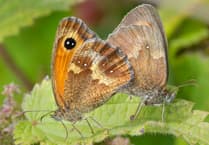The first things to get marked down in our calendars at home are special tides: well-timed spring highs for my husband, so that we can plan boat trips to our favourite beaches from the slipway in Kingsbridge; and daytime spring lows for me, for extreme rockpool expeditions. Sometimes these events coincide, ticking all the boxes and making for ‘a perfect beach day’.

After a fairly dismal summer of inclement weather, other commitments, and our boat, Clio, needing a rotten plank replacing, a final, tiny window of opportunity remained to aim for a ‘near-perfect beach day’. September’s Harvest Moon was also a ‘supermoon’, promising super-tides for both of us. Our son, Oli’s day off also coincided and we were delighted to have both his helming skills and sharp-eyed enthusiasm for some exceptional intertidal foraging.
With schools back and visitors largely gone, the Salcombe-Kingsbridge Estuary shimmered in the silvery morning light, largely un-rippled by boat traffic. Never in a hurry, Clio steamed quietly towards the estuary mouth and into the tidal pull of Salcombe harbour. Heading inshore on the East Portlemouth side we could see ‘our’ beach freshly exposed.

An hour before low tide, Oli and I set off to our favourite rocky outcrop, pausing briefly to say hello to the very territorial blennies awaiting the tide’s return in rock crevices above our encampment. It never ceases to impress me how these ‘fish-out-of-water’ have adapted to survive.
Working our way along one of the sandy-bottomed, rock ravines, we waded into a forest of kelp and red seaweeds at the lowest point of the intertidal zone. Crouching to peer under the dripping overhang, we searched.

“I win!” called Oli, pointing out our first cowrie. Once he had got his eye in, he found several more including one wrapped around in its orange mantle, helping to camouflage it from predators. Blue-rayed limpets, about the size of small fingernails, clustered at the top of kelp fronds, glittering iridescent turquoise in the weak sunshine. Jewel anemones, tentacles withdrawn, stood out as jelly-dots of highlighter pen in neon shades of green and pink. From the roof of the overhang, multi-coloured breadcrumb sponges vied for space with delicate hydroids, pretty star ascidians and great gobs of grey sponge, which hung snot-like as if a party of 1970s punks had just passed through.
Of all the treasures we uncovered, two stood out as exceptional. The first, stretched inside a deep crevice and spotted by Oli, was a spiny starfish, grey-blue in colour and studded with pale spiked plates. As Britain’s largest starfish, this species has been recorded up to 70cm in length and this was only a fraction smaller. The second, I discovered on parting some of the shoreline skirts of seaweed. Movement on the exposed sand revealed a small fish and, on closer inspection, one that was covered in pale blue spots. At last! My first Montagu’s Blenny and one of several species named after nineteenth century Kingsbridge naturalist, George Montagu.
This had definitely turned out to be a perfect beach day.
Two days later, I headed out for another rockpool session, this time with both sons. I had imagined that this was out of common interest in marine life but it soon became clear that they felt I needed a minder or two as this site would be muddy and very slippery. Further from the mouth of the estuary and much more sheltered than the first site, an entirely different assemblage of species awaited us.
Carefully lifting and turning rocks exposed delicate, sponge-encrusted scallops up to about 5cm diameter; strange red tentacled worms, and different types of crustacean. Crab species were numerous, including furrowed, porcelain (both broad-clawed and long-clawed), and feisty, red-eyed velvet swimming-crabs. Squat lobsters are numerous here too and when disturbed, flicker their tail rapidly and audibly so you need to be careful not to drop their rock back on top of them in surprise.
Working my way around to the most sheltered part of the shoreline, I turned my attention to the shaded rock faces, seeking out tiny, solitary Devonshire Cup Corals. Underwater, these could be mistaken for sea anemones, bearing a crown of translucent tentacles above a short, cylindrical stem, but out of water these retract, exposing a white, ceramic-like cup structure with a series of protruding ridges around the top. Delighted to count thirty plus and photographing some of the more colourful examples, I realised it was time to carefully retrace my steps but it was impossible to resist turning over just one more rock. This was truly the jackpot. Looking up at me with electric blue eyes was one of the most exotic creatures I have ever seen on the British shore: a Spiny Squat Lobster.
Even my sons were impressed and I did not stop smiling all the way home.




